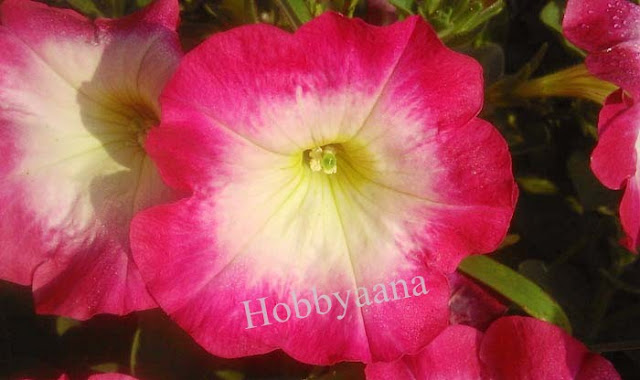Hobbyaana
Petunia Flower How to Plant, Grow, and Care Information and Tips in English
 |
| Petunia Flower care and information |
Petunias are charming and popular flowers known for their vibrant and varied colors, which make them a favorite choice among florists and flower lovers. Belonging to the Solanaceae family, these annual or perennial plants produce trumpet-shaped flowers that are delicate and eye-catching in color. Able to grow in a variety of climates, petunias add color and elegance to gardens, hanging baskets and pots. They can produce abundant blooms with little maintenance, making them an ideal choice for both novice and experienced florists.
A brief history
1. Native South American Origins (late 18th century): Petunia (Petunia spp.) Native to South America, particularly Argentina and parts of Brazil. Indigenous peoples, such as the Tupi-Guarani tribe, were the first to cultivate this colorful flower
2. European introduction (early 19th century): European botanists and explorers brought petunias to Europe after traveling to South America in the early 19th century, fascinated by petunia's attractive appearance, variety of colors and patterns.
3. Botanical classification (mid-19th century): Petunia was formally classified and named in 1823 by French botanist Antoine Laurent de Jussieu. The name "petunia" comes from the French word "petun" which means "tobacco". Petunia is related to the tobacco plant (nicotiana).
In the late 19th century, horticulturists and breeders began cultivating petunias for their ornamental value. These early efforts resulted in the first cultivars, which were predominantly fragrant and had smaller flowers than modern petunias.
Throughout the 20th century, petunias began extensive breeding and hybridization efforts, resulting in the development of varieties including grandiflora, multiflora, and milliflora. These new varieties had larger flowers, unique colors
.jpg) |
| Petunia Flower care and information |
The species
Petunias come in a variety of colors and patterns, making them a popular choice for gardens, hanging baskets and pots. Here are descriptions of different types of petunia flowers:
Grandiflora Petunia, Multiflora Petunia, Milliflora Petunia, Wave Petunia, Surfinia Petunia, Cascading Petunia, Double Petunia, Frilly Petunia, Veined Petunia, Bi-Colored Petunia, Night Sky Petunia, Black Velvet Petunia, Miniature Petunia, Picoti Petunia, and many more. There are, which are of different colors, sizes, shapes,
Planting Petunia:
As we know many people plant petunias in their garden or in pots so today let's know some information about planting this plant.
First the soil is prepared
Soil – 50%
Fertilizer -- 30%
River Sand - 10%
Cocopeat - 10%
Bone meal 150 grams per pot
 |
| petunia potting mix |
Any cultivable soil should be taken. Vermi-compost is the best fertilizer if you can't find it, you can use potash or cow dung.
Mix all these well- now your soil is ready.
At least 6/8 inch tubs should be used for planting petunias.
Always use earthen tubs for planting any plant.
First take the tub. Place an opening on the hole under the tub and add some sand on top of the prepared soil. This allows excess water to drain easily and keep your plant healthy.
Now plant petunia seedlings and give it little water.
 |
| Petunia Flower care and information |
Care:
This plant should always be kept in sunlight.
Never overwater petunias. If there is too much water, its roots will rot and the whole plant will die. But when the plant has many flowers, a little more water is needed.
Be careful during rainy season, during heavy rains, you can keep the tub tilted to the side of the tree.
After a few days, the soil of the tub will be dug a little. What happens if the soil is hollow, the tree is healthy.
Apart from 7/10 days, a little bit of mustard leaves should be rot in water for 2-3 days and its slurry should be mixed with water.
Petunias grow in full sun, meaning they need at least 6-8 hours of direct sunlight per day. However you can keep them in some light shade especially in hot climates.
Pests and Diseases:
Common pests: Watch out for aphids, slugs and budworms. Treat infestations immediately with appropriate insecticides or natural remedies.
Natural solutions: Consider using natural remedies like neem oil or insecticidal soap to control pests. For disease, prune off affected plant parts and avoid overhead watering. Always remove dried flowers to keep the plant healthy, increase the chances of more blooms and avoid fungal diseases.
Companion Plants: Petunias look stunning when paired with other plants that grow in full sun, such as marigolds, verbenas or lobelias.
 |
| Petunia Flower care and information |
In the end
In some plants, after a few days the flowering decreases or stops completely.
I think this is due to regular application of chemical fertilizers.
In the beginning, the results are good but after a few days the soil in the tub starts to deteriorate.
I realized it myself.
Due to regular application of chemical fertilizers, the soil becomes rough and hard, as a result of which the roots of the plants cannot spread properly and the water holding capacity also decreases.
That's why I don't use it myself and I don't recommend it to anyone.
I always use organic fertilizers
Thank You




No comments:
Post a Comment